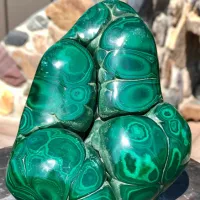Malachite is a unique and vibrant gemstone known for its dark green color and swirl patterns. It has been appreciated for centuries for its aesthetic appeal and metaphysical properties. This blog looks at the different types of malachite, their origins, where they are mined and why this gem has fascinated civilizations throughout history.
Table of Malachite gemstone Types, Origins, and Mines
| Type | Origin | Mines | Discovery Date | Colors |
| Velvet Malachite | Democratic Republic of Congo (DRC) | Katanga, Lubumbashi | Ancient Times | Deep Green with Velvet-like Texture |
| Fibrous Malachite | Russia, Australia | Ural Mountains, Burra Burra Mines | 19th Century | Light to Dark Green Fibers |
| Botryoidal Malachite | Namibia | Tsumeb Mine | Modern Discovery | Green with Concentric Circles |
| Banded Malachite | Zambia, USA | Copper Mines, Bisbee, Arizona | Ancient Times | Banded Shades of Green |
| Chrysocolla Malachite | Israel, USA | Eilat Mines, Arizona | 20th Century | Blue-Green with Malachite Veins |
Description and Overview of Malachite gemstone
Malachite is a copper carbonate mineral that forms in the oxidized upper parts of copper deposits. Its bright green colors, which vary from pastel to deep forest green, are due to the presence of copper in its composition. The swirling patterns seen in the gem are natural formations that result from its unique crystalline structure.
Malachite has been used to make jewelry, sculptures and ornaments for thousands of years. The Egyptians, Greeks, and Romans all admired this stone for its bright green color, using it for amulets, decorations, and even powdered eye shadow. In ancient times, malachite was thought to protect against evil spirits and was worn by children to ward off danger.
Types of Malachite gemstone and Their Value
Velvet Malachite

This type of malachite is known for its soft and velvety texture and dark green color. Velvet malachite is commonly found in the Democratic Republic of Congo, where it has been mined for centuries. Its name comes from its surface, which seems covered with fine fibers. Its rarity and texture give it great value in the gem market.
Reference: Gem Society
Fibrous Malachite

Fibrous malachite forms long, fine fibers that give the stone a unique appearance. This type of malachite is found mainly in the Ural Mountains of Russia and in the Burra Burra mines of Australia. The bright green threads make it a popular stone with collectors.
Reference: Minerals.net
Botryoidal Malachite

Botryoidal malachite occurs as rounded grape-shaped clusters. This variety is often found in the Tsumeb mine in Namibia. The name “botryoidal” comes from the Greek word for “grape” because of its shape. Its layered structure gives it a special look.
Reference: Mindat
Banded Malachite

Banded malachite contains layers of various shades of green, which gives the gem a striated appearance. It is often found in copper mines in Zambia and the United States. Banded malachite is commonly used for decorative pieces and is highly sought after for its visual appeal.
Reference: The Mineral Gallery
Chrysocolla Malachite

A blend of two minerals, chrysocolla and malachite, this gemstone combines shades of blue and green. It is found mainly in the mines of Eilat in Israel and in the state of Arizona in the United States. Its unique color combinations make it a very valuable gem in the jewelry market.
Reference: GIA.edu
History and Origins of Malachite gemstone
Malachite has a long history dating back to ancient Egypt, where it was revered for its vibrant green hues and believed to have protective properties. The Egyptians used malachite not only for ornaments, but also powdered earth for cosmetic and medicinal purposes. In the middle Ages, malachite was used as a talisman to ward off danger and many believed it had healing properties.
The gem was also highly valued by the Russian aristocracy. The famous malachite room in the Winter Palace in St. Petersburg, Russia, contains an extensive collection of malachite used in decoration, highlighting its value as a luxury item.
The origin of malachite dates back to copper deposits found in Africa, Russia and America. Their formation occurs when copper minerals undergo corrosion and oxidation, creating stunning green patterns. Due to the demand for copper, many malachite mines are located near the main copper production areas.
Why Malachite gemstone is Valuable
Malachite is valued not only for its unique green patterns, but also for its metaphysical properties. Throughout history, many cultures have attributed healing and protective properties to malachite. It is often considered a stone of transformation, capable of absorbing negative energies and promoting emotional balance.
Its rarity in large and high-quality pieces also adds to its value, especially when it has well-defined patterns or when mixed with other minerals such as azurite or chrysocolla. The combination of visual appeal and cultural significance make malachite a highly sought after gem in jewelry and art.
FAQs about Malachite Gemstone
1. What is the origin of malachite?
Malachite is primarily found in copper-rich regions like the Democratic Republic of Congo, Russia, and the United States. It forms when copper deposits undergo weathering.
2. Why is malachite green?
Malachite’s green color comes from the copper in its chemical composition, which produces various shades of green depending on the concentration.
3. How should malachite be cared for?
Malachite is a relatively soft stone, so it should be handled with care. Avoid using harsh chemicals and excessive heat to clean malachite as it can damage the surface.
4. What are the metaphysical properties of malachite?
Many believe malachite has protective and healing properties, promoting transformation and emotional balance. It is also thought to absorb negative energies.
Conclusion
Malachite remains one of the most attractive and historically significant gemstones because of its unique patterns, vivid green colors, and historical significance. Whether used for decorative pieces, jewelry or metaphysical purposes, malachite continues to fascinate those who appreciate its beauty and mystery.

